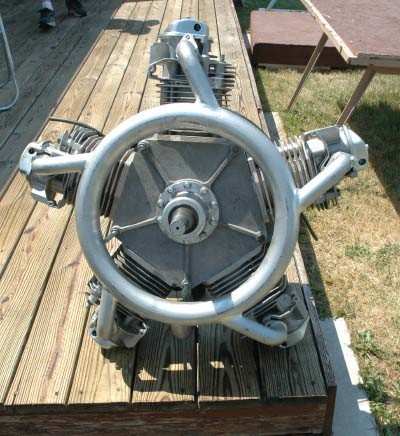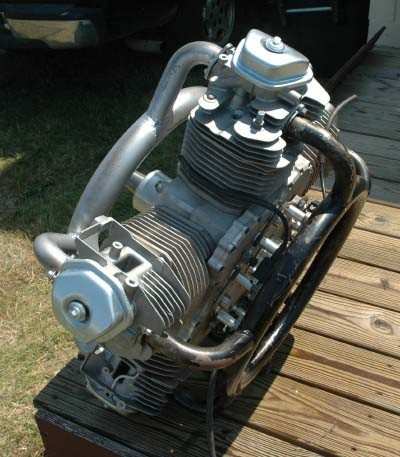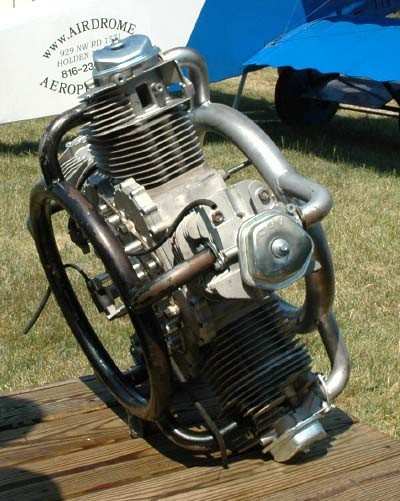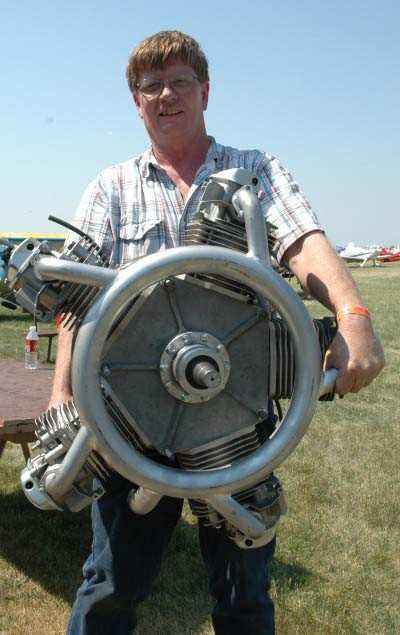On The Trail Of A Radial Alternative To Rotax
by ANN Correspondent Kevin R.C. "Hognose" O'Brien
"What in the blue blazes is that?" I asked, at least partly
involuntarily. I like to think I know aero engines. I've skinned
knuckles on aero engines. I have books on aero engines. (I'm always
looking for more). But this small, five-cylinder radial was a new
one on me. It didn't resemble any of the radials I knew, like
Kinners, Warners or the uncommon experimental HCI.

The engine was sitting on the deck at the Replica Fighters
Association (RFA) building at Oshkosh. One of the RFA members
answered my question, after a fashion.
"It's Tom Preuss's engine," he said. "You have to ask Tom about
it. All I know is that it comes from Australia, it's only $8,000,
and Tom is putting it on an 82% scale Boeing P-26."
This led to a discussion of a P-26 project that has been showing
up at Oshkosh for years; it turns out that's a different plane, a
full-size replica under construction by Tim O'Connor (read more
about it here). When I finally figured out
that we were talking about two different P-26s, a man appeared who
knew all about Tom Preuss's P-26, and all about Tom Preuss's
engine.
He was, in fact, Tom Preuss, and quickly confirmed that he was
building an 82% P-26 based on a heavily modified Bowers Fly Baby
design -- completely different from O'Connor's metal Peashooter.
And now I discovered exactly what it meant that this mystery radial
was "Tom Preuss's engine": Preuss owned it. He knew some details of
the engine, but it was built by someone else. He saw some parts
last year and talked to the guy, and committed to be the launch
customer for the prototype of the engine.
Fortunately, Preuss, an interesting guy who has already built
and is flying a highly modified Loehle P-51 kit, knew who the real
designer was, and I finally had a name: Peter Walker. Walker made
the engine, casting and machining most parts. Walker was, Preuss
said, from New South Wales, Australia. For a moment I forgot how
pleased I was to have found out who made the engine, so
disappointed I was that he was so far away.
"He's not far away right now," Preuss said. "He's right here at
the show. And there he is!" At this point, the man himself
appeared: Peter Walker. After a brief introduction, Preuss went
inside the air-conditioned RFA building and Walker squinted into
the afternoon sun, and told the story of his engine.
Walker's one-man company, Werombi Engineering (Werombi is a
place name in Australia), has but one product, of which exactly one
prototype example existed: the one sitting before us. The R2740
5-cylinder radial engine is designed to make 75 horsepower and the
prototype weighs 149 pounds with manifolds and normal accessories.
Walker thinks that there is the certainty of some weight reduction,
probably about 15 lbs. worth. (Note the picture of Walker holding
the engine).
Walker pointed with pride to certain features of his engine. It
was built to be robust. The head is a standard part that is used on
overhead valve stationary engines -- engines that are used to run
generators or pumps, and which have a similar duty cycle to an
aircraft engine.
"The hard part is up here, in the head," Walker said, pointing
to the cylinder head of stationary-engine provenance. "And that's
already done for us. The rest of it is pretty straightforward."
The cylinder barrels (nikasil lined) and the crankcase are cast
from aluminum alloy and machined; the crankshaft is cast from steel
and machined. Intake manifold and exhaust collector ring are
tubular steel (on the prototype, at least).

The four-stroke engine will make its 75 HP at 2500 RPM. Like the
15 HP one-lung stationary motors from which it's derived, it isn't
straining to do it. It displaces 2740cc, or 167 cubic inches. The
engine should be able to replace the Rotax 582 in many
installations. At least at first, there will be no firewall-forward
packages, and the buyer will have to have a motor mount made;
Werombi Engineering, Walker's company, will provide the drawings
that make it possible. The engines will also ship with an engine
mounting stand which works to line the engine up properly, and sets
it up at the right height, and in the proper attitude, for mounting
or installation.
Many who express interest in the R-2740 are attracted by the
retro appeal of the radial. "Look at what's really happening in
aviation now," Walker urges. "The classic, retro lines of a radial
have a strong appeal." But he's interested in far more than the
"retro" market, stressing that his engine is a reasonable
replacement for the Rotax 582 that offers a longer TBO (he expects
1000 hours) and less sensitivity to maintenance.
He's far from a 582 basher; he's quick to point out that most
people who fail to make TBO or have unexpected stoppages have not
followed the recommended maintenance procedures in the manual. "You
have to use the right oil and the right operating procedures, and
you'll be very happy with a Rotax. This engine [the R-2740] is
designed to be more durable; to get it to break down you'd have to
do extreme things to it, run it without any oil or something." He
was particularly critical of torturing the engine to exact the last
percentage point of performance, at the expense of durability.
"Yes, many pilots don't make TBO. But that doesn't mean the Rotax
is bad. In Europe, they're getting 600 hours out of them." His
advice: adhere strictly to the recommended procedures in the
manual.
And you should still follow the recommended procedures in the
manual with the R-2740; it'll last longer that way.

Until now, Walker hasn't had a website. "Too many guys come here
with a fancy website, with a computer rendering, but no real
product. I told them when I came here last year and showed some
parts that I wasn't going to do a rendering and wasn't going to
make a website full of empty promises. I was going to make and show
people real parts and real engines. So last year I came with parts
and this year with an engine."
"Next year, there should be three planes here with these engines
in them. At least." Walker explained that one kit maker interested
in the engine was Aerolab of Italy, which already offers the Rotec
radial, an unrelated engine that's also from Down Under, in its
two-seater aircraft, which resemble a Spacewalker with the retro
aspects of the design played up. The R-2740 (named for its metric
capacity) would power a lighter, single-seat version. In addition
to Tom Preuss's P-26 scaled replica, several other projects are
under construction.
Meanwhile, back in Australia, Walker has thought of a clever way
to torture test his engine. One will be installed in a Wag-a-bond
that will be placed at a local flying club -- the members will be
able to fly the plane for the cost of fuel only, which he believes
will quickly build up a lot of hours, "in the hands of average
pilots, and maybe some ham-handed ones." This will help him see how
the engine holds up in "real" service.
Peter Walker explained how he planned to sell and service the
engines. As I'd heard, the price is expected to be about $8,000 US.
All sales will be direct, and all warranty service will be through
Werombi Engineering in Australia -- if your engine needs warranty
service, you'll pack it back in its original box and send it back,
and Werombi pays the freight. When the engine is repaired, as long
as the damage isn't due to abuse, it'll be shipped back to the
customer, anywhere in the world.

It will be some time before the jury is in on Peter Walker's new
engine design, but his explanation of its projected advantages is
plausible, and enough early adopters have committed to the engine
that we should know in a finite amount of time how successful the
design is.
Meanwhile, it can be seen on the deck of the Replica Fighters
Association building at Airventure in Oshkosh -- for a limited time
only, before Tom Preuss takes it home to power his P-26
replica.
FMI: www.r2740.com
[note: site is expected to go live soon, but may not be right
now]
 ANN's Daily Aero-Term (04.14.24): Maximum Authorized Altitude
ANN's Daily Aero-Term (04.14.24): Maximum Authorized Altitude ANN's Daily Aero-Linx (04.14.24)
ANN's Daily Aero-Linx (04.14.24) Classic Aero-TV: 'We're Surviving'-- Kyle Franklin Describes Airshow Life 2013
Classic Aero-TV: 'We're Surviving'-- Kyle Franklin Describes Airshow Life 2013 Aero-News: Quote of the Day (04.14.24)
Aero-News: Quote of the Day (04.14.24) Airborne 04.09.24: SnF24!, Piper-DeltaHawk!, Fisher Update, Junkers
Airborne 04.09.24: SnF24!, Piper-DeltaHawk!, Fisher Update, Junkers






